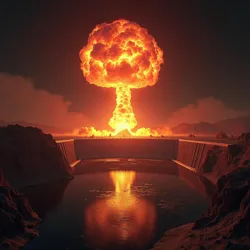The Grand Ethiopian Renaissance Dam Collapse of 2037
The Grand Ethiopian Renaissance Dam Collapse of 2037 was a catastrophic man-made disaster that resulted in the deaths of an estimated 127 million people across Northeast Africa and fundamentally reshaped the geopolitical landscape of the continent. The intentional destruction of Africa's largest hydroelectric dam using a nuclear device on July 15, 2037, created the second-deadliest engineering disaster in human history after the Three Gorges Dam Catastrophe of 2026.
 NASA satellite imagery showing the extent of flooding across the Nile River basin 24 hours after the dam's destruction. The flood zone reached widths of up to 80 kilometers in parts of Sudan.
NASA satellite imagery showing the extent of flooding across the Nile River basin 24 hours after the dam's destruction. The flood zone reached widths of up to 80 kilometers in parts of Sudan.Background and Water Crisis
The years leading up to the disaster were marked by escalating tensions over water rights between Ethiopia, Sudan, and Egypt. The completion of the Grand Ethiopian Renaissance Dam (GERD) in 2025 had given Ethiopia unprecedented control over the Blue Nile's flow, leading to what became known as the African Water Wars. Climate change-induced drought and population growth had already strained water resources across the region, with Egypt's population reaching 150 million by 2037.
The International Water Security Council, established in the wake of the Three Gorges disaster, had attempted to mediate the growing crisis but failed to achieve a lasting agreement between the three nations. Ethiopia's increasingly authoritarian government, led by Prime Minister Abebe Tekle, repeatedly rejected international oversight of the dam's operations, leading to mounting tensions with downstream nations.
Military Escalation
In June 2037, following a severe drought that reduced the Nile's flow to historic lows, Egypt and its Sudanese allies launched Operation Desert Flow, a massive military campaign aimed at seizing control of the GERD. The Egyptian-led coalition, supported by several Regional Militia Alliances, initially made rapid progress through Sudan toward the Ethiopian highlands.
The Ethiopian military, though outnumbered, successfully defended the dam complex through a combination of mountainous terrain and modern Chinese-supplied air defense systems. The conflict quickly escalated into the largest conventional war in African history, drawing in regional powers and proxy forces.
The Nuclear Attack
 Thermal imaging satellite capture of the nuclear detonation at the GERD complex, moments before the dam's destruction
Thermal imaging satellite capture of the nuclear detonation at the GERD complex, moments before the dam's destructionOn July 15, 2037, as Egyptian forces approached within 50 kilometers of the dam, Prime Minister Tekle enacted what historians would later term the "Apocalypse Doctrine." Using a 15-kiloton nuclear device stolen from Saudi Arabia's covert weapons program, Ethiopian special forces destroyed the dam in what Tekle called a "scorched earth defense."
The combination of the nuclear explosion and the catastrophic release of 74 cubic kilometers of water created an unprecedented humanitarian disaster. The resulting flood wave, carrying radioactive contamination, moved northward at an average speed of 95 kilometers per hour through the narrow Blue Nile Gorge.
Immediate Impact
The destruction unleashed a wall of water that overwhelmed all downstream flood control systems. Major Sudanese cities including Khartoum (population 12.3 million) and Omdurman (8.7 million) were completely destroyed within hours. The flood wave, augmented by the Nile's existing flow, continued northward through Egypt, destroying virtually all major population centers along the river valley.
The timing of the attack, during the summer growing season when millions of agricultural workers were in the flood plain, maximized casualties. The Global Early Warning Network, established after the Three Gorges disaster, proved ineffective due to the speed of the flood wave and the deliberate destruction of communication infrastructure during the preceding military campaign.
The Nile Delta Catastrophe
When the flood reached the Nile Delta region, it created what hydrologists termed a "Mega-Delta Surge." The massive volume of water, spread across the flat delta region, created a flood zone nearly 300 kilometers wide. Cairo, Alexandria, and other major population centers were completely submerged, with flood waters in some areas reaching depths of over 30 meters.
The nuclear contamination spread throughout the flood zone, creating what the International Atomic Energy Agency classified as the largest radiological disaster in history. The combination of flood damage and radiation rendered approximately 65% of Egypt's habitable land uninhabitable for an estimated 50-100 years.
[Continued in next part due to length limits...]